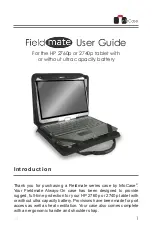
Instruction/Safety Information
31
confirmed by additional research. This device have been tested and found to comply with FCC/IC
radiation exposure limits set forth for an uncontrolled environment and meets the FCC radio frequency
(RF) Exposure Guidelines in Supplement C to OET65 and RSS-102 of the IC radio frequency (RF)
Exposure rules(<1.6W/kg).
WARNING
[For product having the wireless function using 5 GHz frequency bands]
i. the device for operation in the band 5150
–
5250 MHz is only for indoor use to reduce the potential
for harmful interference to co-channel mobile satellite systems;
ii. for devices with detachable antenna(s), the maximum antenna gain permitted for devices in the
bands 5250-5350 MHz and 5470-5725 MHz shall be such that the equipment still complies with
the e.i.r.p. limit;
iii. for devices with detachable antenna(s), the maximum antenna gain permitted for devices in the band
5725-5850 MHz shall be such that the equipment still complies with the e.i.r.p. limits as appropriate;
and
iv. [for devices operating in the band 5250-5350 MHz having an e.i.r.p. greater than 200 mW]
antenna type(s), antenna models(s), and worst-case tilt angle(s) necessary to remain compliant with
the e.i.r.p. elevation mask requirement set forth in section 6.2.2.3 of RSS-247 shall be clearly indicated.
Users should also be advised that high-power radars are allocated as primary users (i.e. priority users)
of the bands 5250-5350 MHz and 5650-5850 MHz and that these radars could cause interference
and/or damage to LE-LAN devices.
Avis d
’
Industrie Canada
[Pour la fonction sans fil (WLAN, Bluetooth, etc.)]
L
’
émetteur/récepteur exempt de licence contenu dans le présent appareil est conforme aux CNR
d
’
Innovation, Sciences et Développement économique Canada applicables aux appareils radio exempts
de licence. L
’
exploitation est autorisée aux deux conditions suivantes :
1) L
’
appareil ne doit pas produire de brouillage;
2) L
’
appareil doit accepter tout brouillage radioélectrique subi, même si le brouillage est susceptible d
’
en
compromettre le fonctionnement.
Exposition aux radiofréquences FCC/IC
Selon les preuves scientifiques disponibles, aucun problème de santé n
’
est associé à l
’
utilisation
d
’
appareils sans fil de faible puissance. Rien ne prouve cependant que ces appareils sont absolument
sans danger. Lorsqu
’
ils sont utilisés, les appareils sans fil de faible puissance émettent de faibles niveaux
d
’
énergie radiofréquence (RF) dans la gamme des hyperfréquences. Bien que les niveaux élevés de
radiofréquence puissent avoir un effet sur la santé (réchauffement des tissus), l
’
exposition à de faibles
niveaux n
’
ayant pas d
’
effet thermique n
’
a aucun impact négatif connu sur la santé.
De nombreuses études sur l
’
exposition aux radiofréquences de faible niveau n
’
ont révélé aucun effet
biologique. Certaines d
’
entre elles ont sous-entendu qu
’
il pourrait y avoir de tels effets, mais leurs
résultats n
’
ont pas été confirmés par des recherches supplémentaires. Les modèles suivants ont été
testés et se sont avérés conformes aux limites d
’
exposition aux rayonnements définies par la FCC et IC
pour l
’
environnement non contrôlé; ils répondent aux règles sur l
’
exposition aux rayonnements RF
(radiofréquence) de la FCC et à celles de la norme RSS-102 d
’
IC.
ENGLISH
Summary of Contents for 17U70Q Series
Page 87: ...Using Windows 11 87 3 The app is added to the Start Screen or taskbar ENGLISH ...
Page 119: ...Using the PC 119 3 Change the settings as needed on the Touchpad item ENGLISH ...
Page 131: ...Using the PC 131 2 Select Bluetooth devices Add device ENGLISH ...
Page 134: ...134 Using the PC 3 Select Edit in Network Internet Ethernet IP assignment ENGLISH ...
Page 164: ...164 Recovering the System 1 Select Remove everything ENGLISH ...
















































